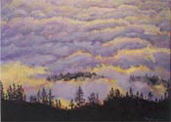Stars and STEM Stories
GLOBE and Art

Science and art have a definite connection — imagine studying prehistoric creatures without being able to see drawings or sketches; or studying contrails in an area that experiences no flyovers by jets; or studying the climate of Polar Regions from the desert with only text. These examples would be reality without the inclusion of art, whether in the form of drawings, paintings, sketches, and photographs. Graeme Stephens, Principal Investigator (PI) of the NASA CloudSat Mission, former GLOBE Principal Investigator for Atmosphere, and currently a University Distinguished Professor at Colorado State University in Fort Collins, CO, is a gifted artist. His oil paintings of clouds line the hallways of Colorado State's Atmospheric Science Building.
Imagine never reading the journal entries or writings of Lewis and Clark, Frederick Marsh, Rachel Carson and others who studied the environment and turned their views of the natural world into descriptions, poetry and retellings. The words of these and many other scientists have helped us "see" what they saw.
So it is also with GLOBE. GLOBE is about students observing their local environment; gathering and entering their data into the GLOBE database. Students are then able to create these data into visualizations of data and then analyze and write reports. But what about the experiences that the students had that couldnt be captured in the numbers? Some text can be entered as metadata — but can metadata do justice to a magnificent sunrise or a flock of geese flying overhead? Are these unimportant or is there a way of documenting these observations?
Why is it that some people care about the environment while others take it for granted? Might it be an experience that the child has at a certain age? Or perhaps its the right experience for that person. Much of it must be connected to the culture and the local environment that a person lives in. Perhaps its connected with treasuring a feeling. Perhaps that special sunrise stirs a certain feeling of peace or tranquility in a person's soul that they wish to capture and relive or share with others. Maybe the numbers making up the data don't fully engage some students, but walking outside to gaze up at the clouds does; and maybe the laboratory part of science doesn't captivate some students the way that the observations and the discovery does. And when you think about it, doesn't the discovering of something new make science more interesting for everyone? Somewhere between the "Aha!" and the "Wow!" factors science becomes more fascinating. Perhaps these metadata represent the first caring experiences that a child exhibits toward their environment.

Ms. Anikó Orgoványi, Country Coordinator for GLOBE Hungary, initiated GLOBE and Art, presenting the proposal during the GLOBE Annual Conference in 2004 in Boulder, CO. (See also The Art of GLOBE GLOBE Star.) Last year, in the Czech Republic, allowed some initial student art presentations, however this year, in Thailand, students were given a larger forum for presenting their art through GLOBE.
28 August 2006





